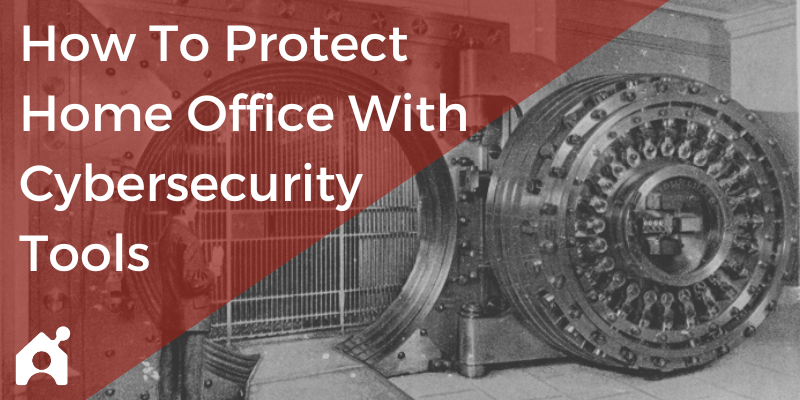5 Home Office Cybersecurity Tools (The Basics)

Remote work has become a risk landscape for cybercriminals to take advantage of the vulnerabilities of home offices. Thus, relocation to a remote environment requires a cybersecurity plan. In this article, you’ll be introduced to five key cybersecurity tools for enhancing your home office so you can work worry-free.
1. Virtual Private Networks
A Virtual Private Network, or VPN, is a popular and secure tool for safeguarding your home office and company-related files. The service operates by routing your web traffic through a protective tunnel that utilizes industry-standard AES-256 encryption. It’s used by militaries and banks, which advocates its reliability.
Thanks to this encryption, your activities, files, and websites you access are invisible to any prying eyes — even your internet service provider. Upon connecting to any VPN server, you receive a different IP address, so your work-related information circulates only between you and the company.
Many businesses incorporate a work-dedicated VPN for Mac and/or Windows, like NordLayer, into their daily processes; employees can also use these in their home offices. But a VPN is absolutely crucial when connecting to public Wi-Fi or other insecure hotspots. They typically have no protection, which makes your device vulnerable to snooping and interception.
2. Password Managers
A password manager or password vault is another tool that is indispensable for personal and business use. While passwords are tedious when they pile up in the face of numerous files and websites needing access, they’re not going away anytime soon. Luckily, most businesses today use password managers to create strong passwords and store them safely in an impenetrable vault.
Weak passwords take up to 30 minutes for experienced hackers to figure out, which results in accessing work information and worse. In fact, a report by Security.org shows that web users who don’t use password vaults are three times more likely to be affected by identity theft.
Moreover, advanced password manager services offer additional features that tighten the security of your home office. They can range from monitoring one’s digital identity for compromised account credentials on the dark web to providing timely alerts in case of breached services. In either case, you’re instantly prompted to renew your credentials, thus halting any threat vectors from causing harm.
3. Antivirus Software
Another no-brainer entry is antivirus software. It fills in the cracks left by other cybersecurity measures, such as a VPN or a password manager. This software is an anti-malware solution to protect your work device from dangerous breaches, viruses, phishing attempts, ransomware, and similar threats.
After all, device-based attacks are still a popular way to steal credentials or other sensitive user data — and it doesn’t matter whether it’s your personal or company-issued device. Antivirus software is an answer to the so-called device-based attacks; it scans and filters offline documents, files, and anything else that enters the digital premises.
Premium antivirus software like Norton, Bitdefender, or AVG typically offers a variety of built-in features that may encompass more than just device-based attacks. Real-time malware protection is one such feature; others include ransomware protection, cloud scanners, and other nifty bits that help build a fundamental layer of security.
4. Cloud-Based Storage Solutions
Cloud storage can accommodate any enterprise data and ease the minds of both employees and employers in the WFH environment. Cloud storage combats advancing cyber threats through regular updates and improvements in cloud security protocols, and it’s helpful for retrieving lost data on top of protecting it from snoopers and nefarious hackers.
Additionally, storing data in the cloud helps workers and companies juggle multiple projects if they’re operating both in the office and remotely. Along with collaboration improvement, this cybersecurity tool eases data access and actively shields sensitive information regarding projects, documents, files, codes, and so on.
Both short- and long-term online storage are available. In a nutshell, short-term cloud systems meet the immediate WFH needs. Conversely, long-term storage is meant for strategic purposes, like migrating latency-sensitive applications, synchronizing authentication tokens, and more. Apart from the company’s granted access to their cloud storages or in their absence, it’s advisable to opt for them for extra security.
5. Two-Factor Authentication (2FA)
Two-Factor Authentication, or 2FA, is an advanced security measure that requires users to provide two or more forms of credentials to log into an account. You may also have heard it referred to as Multi-Factor Authentication, or MFA. Though this practice isn’t a standalone cybersecurity tool like the previously listed ones, it’s necessary. Technically speaking, finding a workplace that doesn’t incorporate 2FA in every account is hard.
Suppose your mobile phone or a laptop you work with is stolen, or a hacker manages to figure out your account’s password. Because of 2FA, the person needs extra steps to confirm access. It could be an authenticator app, a fingerprint, SMS confirmation, or any other extra confirmation step. This measure gives whoever is breaking it a hard time or even virtually no chance of getting in.
Smaller practices should never be overlooked in the context of online security. Though 2FA can seem tedious when you have to perform the extra steps to access data, accounts, and whatnot, it can also save information in critical cases. So, whether your workplace requires it or not, use 2FA everywhere you go — for personal and work-related accounts.
